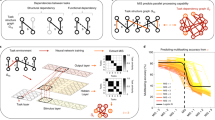Abstract
Because it is time-dependent, parallel computation is fundamentally different from sequential computation. Parallel programs are non-deterministic and are not effective procedures. Given the brain operates in parallel, this casts doubt on AI's attempt to make sequential computers intelligent.
Similar content being viewed by others
References
Boolos, George S. and Jeffrey, Richard C. (1995), Computability and Logic, Cambridge UK: Cambridge University Press.
Churchland, Patricia S. and Sejnowski, Terrence J. (1992), The Computational Brain, London: The MIT Press.
Dennett, Daniel (1993), Consciousness Explained, London: Penguin Books.
Gries, David (1983), The Science of Programming, New York: Springer-Verlag.
Lewis, Harry R. and Papadimitriou, Christos H. (1981), Elements of the Theory of Computation, Englewood Cliffs: Prentice-Hall.
McCulloch, Warren S. and Pitts, Walter (1943), ‘A Logical Calculus of the Ideas Immanent in Nervous Activity,’ Bull. Math. Biophysics 5, pp. 115-133.
McCulloch, Warren S. ‘The Brain as a Computing Machine,’ Electrical Engineering 68 (1949), pp. 492-497.
Minsky, M. (1967), Computation: Finite and Infinite Machines, Englewood Cliffs: Prentice-Hall.
Penrose, Richard (1990), The Emperor's New Mind, London: Vintage Books.
Searle, John (1990). ‘Is the Brain's Mind a Computer Program?’, Scientific American, Jan. 1990, pp. 20-25.
Turing, Alan M (1936), ‘On Computable Numbers, With an Application to the Entscheidungs problem,’ Proc. London Math Soc. Ser. 2 42, pp. 230-265.
Turing, Alan M. (1950), ‘Computing Machinery and Intelligence,’ Mind 59, pp. 433-460.
von Neumann, J. (1951), ‘The General and Logical Theory of Automata,’ in Jeffress, Lloyd A. (Ed.), Cerebral Mechanisms in Behavior: The Hixon Symposium, New York: John Wiley & Sons, pp. 1-31.
Author information
Authors and Affiliations
Rights and permissions
About this article
Cite this article
Boucher, A. Parallel Machines. Minds and Machines 7, 543–551 (1997). https://doi.org/10.1023/A:1008284405861
Issue Date:
DOI: https://doi.org/10.1023/A:1008284405861




